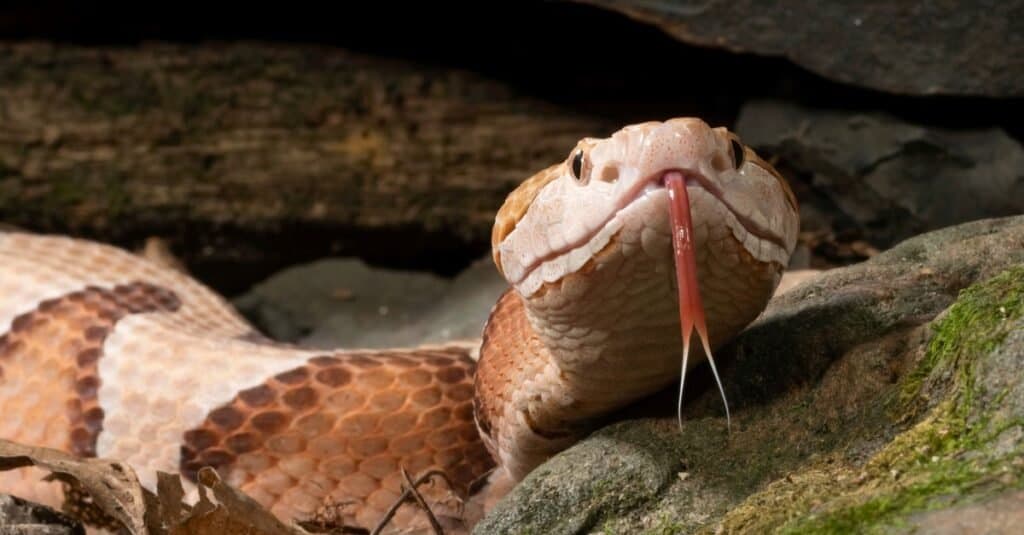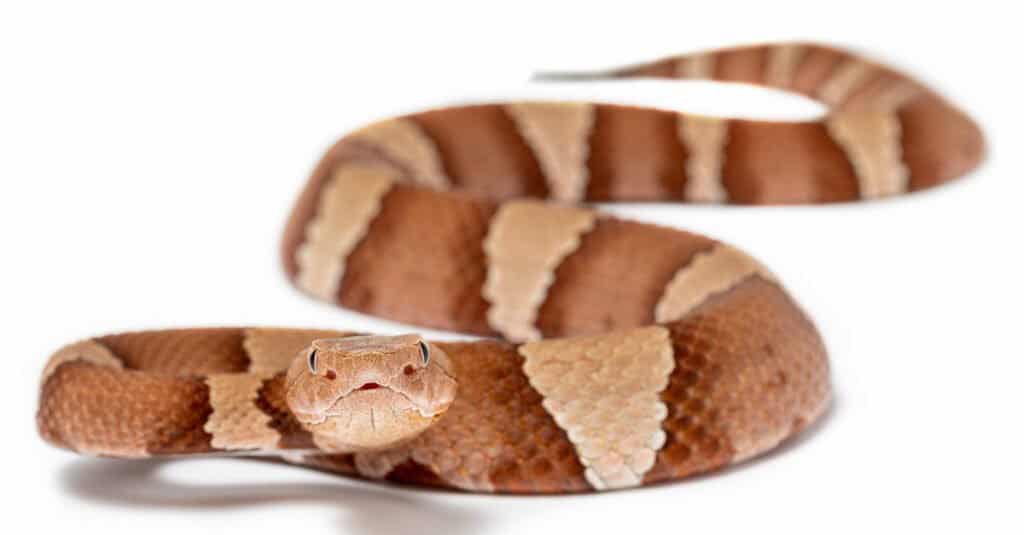They camouflage beautifully, lying in wait for the moment their prey comes close enough for them to strike. But it’s not just how fast they move or how venomous they are that keeps prey quaking in their figurative boots! Copperheads also have a unique ability to sense the most subtle changes in heat. Discover why copperheads have heat-sensing detectors and how that makes them such feared predators!
Copperhead Overview
Copperheads are venomous snakes endemic to North America. In areas where these snakes are common, snakebites occur with humans and pets. They’re not aggressive snakes, but they do react defensively when an animal attacks or when a person accidentally steps on them. Left to their own devices, however, they move right along living out their lives as a helpful species for rodent control.
These snakes have distinctive markings on their bodies that are most often described as Hershey’s shaped kisses lined up on the sides of their bodies. If you’re looking at them from right above their bodies, the markings meet in the middle, creating the appearance of hourglasses. The markings are quite similar to that of a cottonmouth, though there are some key differences between these two species that can help with identifying them.

Copperheads have distinctive markings on their bodies in Hershey’s kiss-shaped formations on either side of their bodies. From an aerial perspective, they appear like hourglasses.
©JacobLoyacano/Shutterstock.com
When copperheads are first born, they’re fully equipped with functional fangs. These babies can release venom just like their adult counterparts! They are quite small and easy to overlook, but you can tell when they’re young because the tip of their tails is kind of a yellowish-green color. When they mature, that color changes to match the rest of their bodies.
The Copperhead Diet
Considering they’re known as beneficial rodent control, you can imagine they like devouring rats and mice. These are carnivorous creatures that need meaty food sources for survival. While they seem to have a preference for mice, they also eat large insects like cicadas. If you hear cicadas and you live in an environment copperheads inhabit, it’s possible there are some copperheads roaming about, enjoying ample snacks.
These thick-bodied snakes also enjoy feasting on other small snakes, small birds, and amphibians like toads and frogs. They eat baby cottontails and baby turtles, as well! Their diet is varied, and their hunting strategy relies on the good ol’ ambush style. Unsuspecting prey can’t make a run for it, which is what copperheads rely on. They either devour their prey at the moment they strike, or they let their venom do its work while they keep a close eye on their future meal. But it’s not just their venom that works in their favor. It’s also their heat-sensing detectors.
What Are Heat Sensing Detectors?
The name is pretty telling — copperheads can sense heat. But it’s only because they have highly specialized pit organs that allow them to pick up on changes in temperature. Copperheads aren’t alone in this unique ability — other pit vipers and rattlesnakes are also equipped with heat-sensing detectors. Neurons communicate with the pit organs, but scientists still don’t have a solid grasp on exactly how that communication occurs. The electrophysiological responses depend on the pits located right in the center between each of a copperhead’s eyes and nostrils.

Copperhead snakes have heat-sensing detectors located between their eyes and nostrils.
©Joe McDonald/Shutterstock.com
Their ability to sense heat is so acute that the change in temperature doesn’t have to be drastic. They can pick up on even slight changes. With this ability, they can more effectively strike at their prey. This accuracy makes them successful predators, whether they employ the standard ambush technique or actively go out and hunt to find something suitable to devour.
Their heat-sensing detectors are instrumental in helping a copperhead locate prey. But its tongue gets in on the action too, helping them “taste” the air. Their prey leaves scent trails which they are equipped to pick up on. They can follow the scent trail to locate the prey. When they’re close and visibility isn’t clear, they use their heat-sensing detectors to help them finish the job.
Why Copperheads Have Heat-Sensing Detectors
Although heat-sensing detectors help a copperhead strike accurately at potential prey, they also serve another purpose. When looking for the right environment to settle into, a copperhead can scan first to determine where it might be able to soak up some sun. These are cold-blooded animals that rely on external heat sources to regulate their body temperature. Being able to scan for an environment to bask in enables their survival just as much as being able to detect prey even under the cover of nightfall (or foliage!).
How Heat-Sensing Detectors Make Copperheads Such Feared Predators
It’s impressive enough that copperheads can extend their jaws to swallow their prey whole. They can also shift their organs around to make room for the large, meaty meals they go after. But their prey has more than that to worry about. Mice, for example, avoid open areas and try moving along quickly to avoid predators. They hide when a threat is near, but the problem is copperheads can detect them even when they’re hiding. For mice and other prey animals, it’s a doomed game of hide-and-seek.

Copperheads are impressively skilled at locating their prey using their heat-sensing detectors.
©Scott Delony/Shutterstock.com
When Do Copperheads Use Their Venom?
Copperheads use their tongues and heat-sensing detectors to track and locate prey. They reserve their venom for when it’s time to kill their prey. These snakes aren’t chewers. It’s all in at once for them. To keep their prey from getting away, they inject their venom to subdue them. This is the prime time when they use their venom. A copperhead’s venom is hemolytic, which means that after it’s injected, red blood cells begin breaking down. Whatever fight the prey animal has left in it starts to dissipate, which makes it easy for the copperhead to swallow the subdued animal whole.
However, a copperhead may also strike, bite, and inject venom if it feels threatened. Provocation by another animal or an accidental encounter with a human could result in a copperhead bite. Fortunately, copperhead bites are rarely fatal to humans or pets. In cases where a copperhead bites a pet, the pet requires immediate medical intervention. Veterinarians can administer anti-venom and prescribe medication for pain management. Though copperhead bites can be fatal to pets, with quick intervention, they often make a full recovery. It’s rare for a copperhead bite to be fatal to humans but there are some populations like the elderly and immunocompromised who may experience more severe reactions.
Do Copperheads Attack Humans?
Copperheads can’t eat humans, so they’re not interested in you. In fact, they view humans as predators! They would rather avoid contact than have an interaction with humans when they’re out and about minding their own business. However, there are times when you might encounter a copperhead on a trail or even in your backyard, depending on where you live. In those cases, you should give them space. They’ll move along on their own.
Anita Koziarski, Animal Control Officer for the Town of Cary in North Carolina told A-Z-Animals, “[Copperheads] only defend themselves when they feel threatened. The majority of copperhead bites occur when people try to handle a snake by themselves.” Attempting to relocate a copperhead snake can be dangerous if you don’t know what you’re doing — if you need one relocated, it’s best you reach out to your local animal control service.
The photo featured at the top of this post is © Creeping Things/Shutterstock.com
Discover the "Monster" Snake 5X Bigger than an Anaconda
Every day A-Z Animals sends out some of the most incredible facts in the world from our free newsletter. Want to discover the 10 most beautiful snakes in the world, a "snake island" where you're never more than 3 feet from danger, or a "monster" snake 5X larger than an anaconda? Then sign up right now and you'll start receiving our daily newsletter absolutely free.
Thank you for reading! Have some feedback for us? Contact the AZ Animals editorial team.






